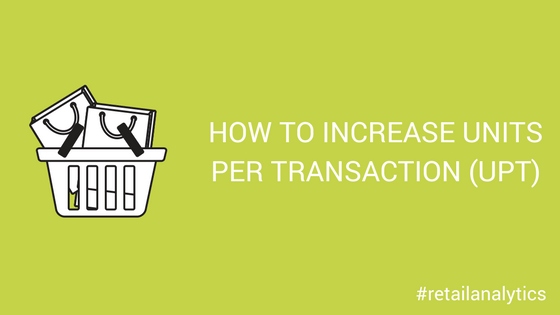What does UPT stand for? Let us understand the KPI or sales metric terminology UPT in detail and how it is useful in retail business
While conducting any business, it’s crucial to keep a record of your transactions. Various KPIs or metrics measure purchases, sales, or other business transactions.
One KPI or sales metric used to measure the average transaction is Unit Per Transaction. It is also abbreviated as UPT.
Unit Per transaction helps the retailer watch the success of sales initiative and other aspects in better prospects.
Let us have a closer look at UPT, the importance of UPT, the formula for calculating this metric. Also, listed are the 4-steps procedure for calculating this metric, and some valuable tips for increasing the UPT.
Quick Navigation
What Does UPT Stand For – What Is Unit Per Transaction (UPT)?

The retail sales sector uses the terminology of Unit Per Transaction. Sometimes, Unit Per Transaction (UPT) is also known as Items Per Customer (IPC). This sales metric helps the retailer give them a broader picture of the customers’ transactions.
UPT is a unit of measurement for an individual transaction. It can be used to measure the profitability of a single transaction, or it can be used to compare the profitability of multiple transactions.
Your business must measure and track how much product you are selling. Furthermore, it is a reporting method for sales by monitoring a certain number of units sold to a customer.
What Is The Importance Of Measuring UPT?
Unit per transaction is a metric that shows the number of units per order or sale. It can also refer to the number of units for sale per unit of time, such as “20 sales per day”.
When selling a product, it is necessary to focus on the unit per transaction. This metric can indicate whether your customers are purchasing more or less than they usually do.
Businesses use this measurement to track the sale of their product and will often use this data to define pricing strategies. It is also appropriate to measure total sales revenue for an entire company or any subset of the company.
UPT is used with Average Transaction Value (ATV) & conversion for calculating the sales process and sales team’s effectiveness.
The Formula For Calculating The UPT
UPT can be calculated on a daily, monthly, or yearly basis. Many people measure UPT daily for more precise and accurate data.
The average UPT for brick-and-mortar stores can be as high as six to seven customers. While online retailers or stores have an average UPT of three to four transactions per customer.
The quantity of units sold by a retailer to a customer in a given period is known as Units Per Transaction. It is calculated by dividing the count (number) of transactions by the total number of customers.
Formula:-
Unit Per Transaction (UPT) = Number of Units Sold / Number of Transactions.
For example: In May, a store sells 5000 widgets and places 1000 transactions. The unit per transaction can be calculated by dividing the sales by the number of transactions.
So, in this case, 5000 divided by 1000 will result in 5. The UPT in May is 5. That means, on average, each customer purchased 5 widgets from the store in May.
If you’re selling widgets for $5 each, and one customer buys 10 widgets, your unit per transaction (UPT) is $50. Suppose another customer buys 2 widgets that cost $10 UPT. The customer who bought 10 widgets spends more money than those who bought two.
The 4-Steps Procedure To Measure UPT Efficiently And Effectively

Step 1: Set up business goals
This is the primary step to measure UPT. Firstly, understand your goal or the objective based on the information you need.
You need UPT to find out anything such as an employee’s sales performance or your business cycle. After considering your goal, you are ready to go ahead.
Step 2: Consider the duration based on your objective
Deciding for what duration you want to set your goals is the second and foremost step. Based on your set goals, you can determine the period. It can be based on a daily, weekly, monthly, or yearly basis.
Step 3: Further segregate the collected data.
According to your set duration, collect the entire data. Now, you can further segregate it into various categories as you have the information.
Keeping the goal ahead, you can segregate your figure based on employees’ sales performance, team performance, area-wise, or other aspects.
The segregation process majorly depends on what scale you are conducting your business. It may be small-scale or large-scale.
If you conduct it on a small scale, a person can do segregation. You may use the automated features on a large scale for cost-effective and efficient results.
Step 4: Finally, calculate the UPT
This is the last step of the four-step procedure. You can calculate the UPT by dividing the sales by the transactions. You’ll get the results based on the duration you’ve set for the measurement.
Some people use this calculated data to get a broader picture of sales performance in the set duration. A greater UPT results in good business conduct.
The collected average data can be used for enhancing your business objectives. This is an excellent sales metric for figuring out the improvement areas of business.
Some of the valuable tips for increasing the Unit Per Transactions (UPT)
To increase the UPT, it is essential to have a high enough conversion rate. This means that most people who visit your website or store will follow through with a purchase or sign up.
You can increase your conversion rate by creating a call-to-action button on your website. This gives consumers several ways to buy products based on their needs.
There are many ways to increase the UPT, but what’s most important is not to neglect the small details.
Things that can help improve the UPT include
- Build a platform of strong and effective customer relationships
This is the most fundamental step for generating sales. If you succeed in keeping your customer happy, the customer is more likely to purchase the product from you the next time. A strong customer relationship is developed when you can serve the right products at the table.
If a customer wants to purchase a camera, how well you use your marketing skills to engage the customer matters. The salespeople should be able to provide tactical services to their customers. A customer’s purchasing journey is based on the marketing skills used by the salesperson. They are solely responsible for converting their lead into sales.
- Engage your customer by serving many products of the same item
This is one of the most workable tips for generating more transactions from a customer. If a customer is looking for a single product, you can diversify the attention by showing multiple sub-categories of the products.
You can create a picture in your customer’s minds by providing why they should buy other products. One more effective way of multiplying your transactions is by offering discounts.
You can provide a combo offer to your customers. For example: – You can show how buying three things together can affect their price. The customer will probably switch to the combo offer as it will be cost-effective.
- Implement free shipping and giveaways
It is also a good idea to offer free shipping and giveaways to those who sign up to your email list in an online business. If you are running a store, you can create urgency and offer free delivery if they purchase the item today only.
You can also offer free shipping on orders over a particular price. If a customer is not in a rush, this will give them time to think about their purchase before they pay for it. Another way is to offer freebies with every purchase or coupon for those who buy more than one item.
- Offering discounts and guarantee over products
This is the step where you’ll be offering the product along with a trust. If something doesn’t work, it can be returned or exchanged. This creates satisfaction in the customer’s mind.
A store can also offer a discount for those who spend at least $50 or any other price. You can offer discounts on items purchased in bulk.
Another idea is to emphasize in-store shopping, as it’s been shown that people spend more when they’re in a retail environment.
Nowadays, online shopping is boosting its role in the market. You can offer discounts, free shipping, giveaways, coupons, etc.
Conclusion
Unit Per Transaction (UPT) is highly used for calculating average data. The stores implement this tactic to get fruitful results.
You can primarily increase the UPT by incentivizing customers to buy more and implementing the beneficial tips for improving the UPT.

